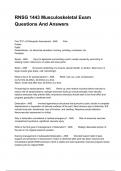RNSG 1443 Musculoskeletal Exam
Questions And Answers
Five "P's" of Orthopedic Assessment - ANS Pain
Pulses
Pallor
Paraesthesia - an abnormal sensation: burning, prickling, numbness, etc.
Paralysis
Sprain - ANS Injury to ligaments surrounding a joint; usually caused by wrenching or
twisting motion. Most occur in ankle and knee joints.
Strain - ANS Excessive stretching of a muscle, fascial sheath, or tendon. Most occur in
large muscle grps (back, calf, hamstrings).
What is the tx for sprains/strains? - ANS RICE- rest, ice, cold, compression
Ice for first 24-48hrs, 20-30min at a time
Warm, moist heat after that, 20-30min at a time
Pt teaching for strains/sprains - ANS Warm up, then stretch muscles before exercise to
reduce risk of sprains/strains; strength exercises build up muscle strength, bone density;
balance exercises help prevent falls; endurance exercises should start at low level effort and
progress gradually to moderate level.
Dislocation - ANS Involves ligamentous structures that surround a joint; results in complete
displacement or separation of articular surfaces of the joint. Most obvious sign is deformity. S/S
include local pain, tenderness, loss of function, and swelling. Requires prompt attention.
Neurovascular assessment is critical.
Why is dislocation considered a medical emergency? - ANS Risk of avascular necrosis,
compartment syndrome, significant vascular injury
What is the first goal of management of dislocation? - ANS Realign dislocated portion of
the joint in it's original anatomic position
Nursing management of sublaxation/dislocation - ANS Directed toward relief of pain,
support and protection of injured joint; motion is restricted after joint has been reduced and
immobilized; gentle ROM exercises if joint is stable and well supported; exercise program slowly
restores joint to original ROM
, Pt teaching for sublaxation/dislocation - ANS Teach purpose of ROM exercises; pt should
gradually return to normal activities; a patient who has dislocated a joint may be at > risk for
repeated dislocations b/c of loose ligaments; teach pt importance of compliance w/activity
restrictions, if imposed, on affected joint to decrease risk of repeated dislocations
Repetitive strain injury - ANS Injuries resulting from prolonged force, or repetitive
movements and awkward postures, AKA overuse syndrome. Repeated mvmts strain the
tendons, ligaments, and muscles, causing tiny tears that become inflamed. Exact cause
unknown.
Carpal tunnel syndrome - ANS Condition caused by ontinuous wrist mvmt, causing
compression of the median nerve that enters the hand through the narrow carpal tunnel. Assoc
with hobbies/occupations that require continuous wrist mvmt. S/S incl weakness (esp thumb),
numbness, impaired sensation, burning pain, difficulty with fine motor skills, positive Timmel's
sign and Phalen's sign.
Timmel's Sign - ANS Hand numbness when tapping over median nerve as it passes
through the carpal tunnel in the wrist.
Phalen's Sign - ANS Numbness/tingling when wrists allowed to fall freely into max flexion
for >60 secs
Nursing management of carpal tunnel syndrome - ANS Directed toward relieving
underlying cause of nerve compression; wound care; pain mgmt; neurovascular assessment;
educate on risk factors
Pt teaching for carpal tunnel syndrome - ANS Stop aggravating mvmt; proper ergo; use
adaptive devices; splints to hold wrist in slight extension to decrease pressure;
keyboard/mousepad supports
Rotator Cuff Injury - ANS 4 muscles that stabilize the humeral head and rotate the
humerus; a tear can result in subluxation or dislocation; MRI to dx; repetitive overhead motions;
S/S incl shoulder weakness, pain, decreased ROM; usu severe pain when arm is abducted btw
60 and 120 degrees (the painful arc)
Drop Arm Test - ANS Dx aid for rotator cuff injury; the arm falls suddenly after the pt is
asked to slowly lower arm to the side after it has been abducted 90 degrees
Nursing management of rotator cuff injury - ANS Rest, ice, heat, NSAIDS, corticosteroid
injections; ultrasound, PT can also be ordered
Frozen Shoulder - ANS Arthrofibrosis of the shoulder (stiffness, pain, and ltd ROM) after a
rotator cuff injury due to prolonged immobility




